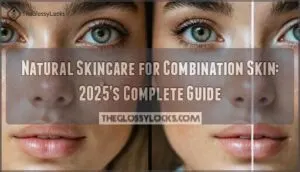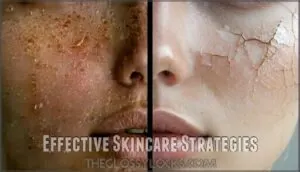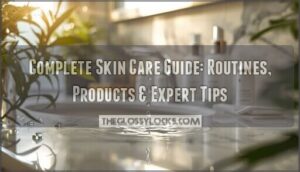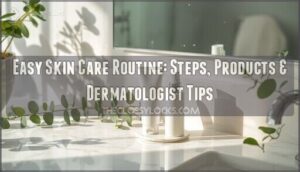This site is supported by our readers. We may earn a commission, at no cost to you, if you purchase through links.

You’re dealing with an oily T-zone and dry cheeks simultaneously – it’s like having two different skin types on one face.
The secret lies in gentle balancing acts rather than harsh treatments.
Jojoba oil mimics your skin’s natural sebum, while aloe vera soothes without clogging pores.
Almond oil provides lightweight moisture that won’t overwhelm oily areas.
Skip alcohol-based products that strip your skin and trigger more oil production.
Instead, focus on pH-balanced cleansers and targeted treatments.
The right approach transforms this tricky skin type into your greatest asset.
Table Of Contents
- Key Takeaways
- Combination Skin Characteristics
- Natural Skincare Ingredients
- Morning Skincare Routine
- Effective Skincare Strategies
- Lifestyle Factors Impact
- Frequently Asked Questions (FAQs)
- How to fix combination skin naturally?
- What type of skincare is best for combination skin?
- What is a good skin care routine for combination skin?
- Can combination skin change with age?
- How often should I exfoliate combination skin?
- What seasonal adjustments does combination skin need?
- Are clay masks safe for combination skin?
- How long before seeing natural skincare results?
- Conclusion
Key Takeaways
- You’ll need different approaches for different zones – use lightweight, oil-free products on your T-zone while applying richer moisturizers to dry cheek areas for optimal balance
- Natural ingredients work best for combination skin – jojoba oil mimics your skin’s natural sebum, aloe vera soothes without clogging pores, and gentle pH-balanced cleansers prevent overproduction of oil
- Consistency beats perfection in your routine – stick to gentle cleansing twice daily, targeted treatments, and give products 4-6 weeks to show results rather than constantly switching products
- Your skin changes with hormones and seasons – adjust your routine throughout the year with heavier creams in winter and lighter formulas in summer while managing stress and diet for better skin balance
Combination Skin Characteristics
Your combination skin creates a unique puzzle with its oily T-zone and dry cheeks working against each other like mismatched roommates.
This skin type affects most people worldwide and stems from genetics, hormones, and environmental factors that make your face behave like two different skin types at once, involving hormones.
Oily T-Zone Issues
Your T-zone often becomes a shiny battlefield where sebaceous glands work overtime.
Your oily T-zone wages daily war against shine and breakouts.
This oily area attracts dirt and creates the perfect storm for breakouts and enlarged pores. The sebaceous glands’ activity is influenced by genetics, hormones, and environmental factors.
- T-zone shine appears strongest on your forehead and nose
- Sebum control requires gentle, oil-free cleansers twice daily
- Blackhead removal works best with salicylic acid treatments
- Pore minimizing toners help tighten enlarged openings
- Acne prevention starts with non-comedogenic products for oily patches
Dry Cheek Concerns
Your cheeks often feel tight and flaky while your T-zone stays oily.
This contrast creates unique challenges for combination skin care. Dry cheeks need targeted Cheek Hydration and Barrier Repair without worsening oily areas.
Skincare can be challenging, but natural remedies offer a balanced approach.
| Concern | Symptoms | Natural Solution |
|---|---|---|
| Flaking | Visible dry patches | Gentle Exfoliation with oatmeal |
| Redness | Irritated, sensitive skin | Aloe vera for Redness Reduction |
| Tightness | Uncomfortable pulling sensation | Product Selection with hyaluronic acid |
| Rough texture | Bumpy, uneven feel | Natural skincare oils like jojoba |
Genetic Influences
Your family tree holds the blueprint for your combination skin characteristics.
Gene expression determines whether you’ll inherit your mom’s oily T-zone or dad’s dry cheeks.
Heritability factors control sebum production levels and skin barrier strength across different facial zones.
Ancestry influence shapes how your skin responds to environmental changes, making skin type identification easier when you understand your genetic background.
Hormonal Shifts Impact
Hormonal fluctuations create a rollercoaster ride for combination skin throughout your life.
During your menstrual cycle and teenage acne years, androgens boost sebum production in your T-zone while estrogen drops dry out your cheeks.
Pregnancy changes and menopause effects further disrupt skin balance, making natural ingredients for skincare essential for managing these endocrine disorders effectively, which is why hormonal fluctuations are crucial to understand.
Natural Skincare Ingredients
Nature provides powerful solutions that work perfectly for your dual-zone skin challenges.
You’ll discover how ingredients like almond oil and aloe vera can balance your oily T-zone while nourishing those stubborn dry patches on your cheeks.
Almond Oil Benefits
Almond oil transforms combination skin care with its unique molecular structure.
This lightweight natural ingredient delivers deep hydration without the heavy feel that clogs pores.
Here’s why almond oil works for your skin:
- Almond Oil Hydration penetrates quickly while maintaining your skin’s natural balance
- Anti-inflammatory Effects calm irritated areas without triggering breakouts in your T-zone
- Skin Barrier Repair strengthens protection while gentle Almond Oil Cleansing removes impurities effectively
Its low Pore-Clogging Potential makes it perfect for combination skin care tips focused on natural skincare ingredients.
Aloe Vera Uses
You’ll discover aloe vera works like a gentle superhero for combination skin.
This natural ingredient delivers soothing irritation relief while providing hydration benefits to dry patches.
Aloe vera’s anti-inflammatory properties offer redness relief and gentle exfoliation without harsh chemicals.
Its lightweight gel texture won’t clog pores in your T-zone, making it perfect for plant-based skincare routines targeting acne reduction across different skin zones.
Aloe vera can also help with itchy scalp relief, providing an additional benefit to its skincare advantages.
Jojoba Oil Advantages
Jojoba oil acts like your skin’s best friend because it mimics natural sebum production perfectly.
This plant-based skincare superstar provides gentle hydration while maintaining moisture balance across your combination skin.
It minimizes pores in oily areas without clogging them and strengthens your skin barrier.
Unlike heavy oils, jojoba achieves sebum balance naturally, making it ideal for natural ingredients routines.
Essential Oils Role
Beyond balancing your T-zone’s oil production, essential oils tackle combination skin’s dual nature with targeted precision.
These concentrated plant extracts offer customized solutions when properly diluted with carrier oils like jojoba or rosehip.
- Oil benefits: Tea tree reduces T-zone shine while chamomile soothes dry cheeks
- Blending guide: Mix 2-3 drops essential oil per teaspoon carrier oil for safe application
- Application methods: Spot-treat oily areas with geranium; use lavender on dry patches
- Safety concerns: Always patch-test and avoid photosensitive oils like bergamot during daytime
Morning Skincare Routine
Your morning routine sets the tone for balanced combination skin throughout the day.
Start with gentle cleansing to remove overnight buildup without stripping your skin’s natural oils, then apply lightweight hydrating products that won’t clog your T-zone or leave dry areas feeling tight.
Gentle Cleansing Tips
How should you cleanse combination skin without triggering more oil or dryness? Choose gentle cleansers with natural ingredients like aloe vera or oat extract.
Use lukewarm water temperature and cleanse twice daily. Avoid harsh tools – your hands work best.
Always patch test new products first to prevent irritation on sensitive areas, using gentle cleansers is key to maintaining skin health.
Hydrating Moisturizers
Since combination skin needs different care for different areas, you’ll want water-based moisturizers that hydrate without adding heaviness.
Lightweight options with non-comedogenic ingredients work best for your T-zone while still nourishing dry cheeks.
Many people purchase water-based skin products to address hydration.
Look for humectant benefits from natural ingredients like hyaluronic acid that draw moisture without clogging pores—your skin will thank you later.
Sunscreen Importance
Sunscreen serves as your skin’s daily bodyguard against UV damage and premature aging.
Choose broad-spectrum SPF 30+ formulas with zinc oxide for reliable UVA and UVB protection. These lightweight, non-comedogenic options prevent skin cancer while controlling shine in your T-zone.
Daily sun protection reduces aging signs by up to 50% according to dermatology research.
Many people seek sunscreen for combination skin to address their specific needs for daily sun protection.
Makeup Removal Techniques
Proper makeup removal protects your combination skin from clogged pores and irritation.
Natural ingredients and gentle techniques work best for this delicate skin type.
- Oil-based cleansers dissolve stubborn makeup without stripping natural oils
- Micellar water lifts impurities gently from sensitive areas
- Double cleansing guarantees complete removal with a gentle cleanser follow-up
- Gentle wipes work for quick touch-ups but aren’t daily solutions
- Eye makeup removal requires extra care with specialized gentle formulas
Effective Skincare Strategies
You’ll master combination skin when you target each zone with specific strategies that work with your skin’s natural patterns.
The key lies in balancing oil control in your T-zone while delivering deep hydration to your cheeks—think of it like being a skin diplomat who speaks two different languages fluently, utilizing complete concepts to achieve harmony.
Balancing Oil Production
Niacinamide works like your skin’s personal oil referee, regulating sebum production while mattifying agents keep your T-zone shine-free.
Clay masks absorb excess oil twice weekly, while oil-free hydration maintains your skin’s moisture barrier.
Jojoba oil tricks your combination skin into producing less sebum by mimicking natural oils. This dual approach prevents oiliness without triggering compensatory oil production that harsh products cause, ensuring a balanced skin care routine with oil-free hydration.
Hydrating Dry Areas
While balancing oil production, your combination skin’s dry areas need Targeted Emollients like shea butter and ceramides.
Humectant Selection matters—hyaluronic acid draws moisture without heaviness.
Occlusive Benefits from jojoba oil lock in hydration overnight.
Overnight Masks provide intensive repair for parched cheeks.
Layering Hydration works best: apply lightweight serums first, then heavier creams to dry zones for balanced hydration.
Exfoliating Techniques
When dealing with combination skin exfoliation, you’ll want to treat your T-zone and cheeks differently.
Gentle exfoliant options work best to remove dead skin cells without irritating either zone.
- Chemical Peels – Use mild lactic or salicylic acid treatments twice weekly
- Physical Exfoliation – Apply DIY scrubs with oatmeal only to oily areas
- Enzyme Exfoliation – Try papaya masks for gentle combination skin exfoliation
Your exfoliation frequency should vary by zone.
Selecting the right skin exfoliant products is essential for maintaining balance.
Serum Application Tips
After proper exfoliating techniques, serum application becomes your secret weapon for balanced skin.
Target different zones with water-based serums for combination skin needs. Apply thinnest to thickest consistency for ideal absorption techniques.
One key ingredient is hyaluronic acid benefits for deep hydration.
Here’s your serum layering guide:
| Oily T-Zone | Dry Cheeks |
|---|---|
| Niacinamide serum | Hyaluronic acid serum |
| Oil-control formulas | Hydrating natural ingredients |
| 2-3 times weekly | Daily application |
Perfect serum frequency maintains skin hydration without overwhelming either zone.
Lifestyle Factors Impact
Your daily habits have a bigger impact on your combination skin than you might think.
From what you eat to how you handle stress and seasonal changes, these lifestyle factors can either help balance your skin or make those oily and dry patches even more challenging to manage, which ultimately affects your combination skin.
Diet Impact on Skin
Your diet directly affects your combination skin’s balance and appearance.
What you eat becomes what your skin shows – feed it right, and it’ll reward you with balance.
Sugar intake spikes insulin levels, which increases oil production in your T-zone while potentially drying out your cheeks.
Inflammatory foods like processed snacks can worsen both oily and dry patches.
Focus on antioxidant sources such as berries and leafy greens to support skin health.
Proper hydration effects show up as improved moisture balance, while gut health influences your skin’s overall function through reduced inflammation.
Stress Reduction Methods
Stress-triggers can wreak havoc on combination skin by increasing oil production and inflammation. You’ll notice breakouts appear faster when you’re overwhelmed.
Try meditation techniques and breathing exercises to calm your nervous system. Yoga benefits include better circulation and hormone balance.
Prioritize sleep quality since your skin repairs itself overnight. Mindfulness practices help you recognize stress patterns affecting your skin balance.
These holistic skincare approaches work alongside natural ingredients to maintain healthy combination skin. Consistent sleep also helps in managing hormonal changes.
Weather Adaptation Tips
Your combination skin faces different challenges throughout the year. During Cold Weather, switch to heavier creams with natural ingredients like shea butter for dry cheeks while using lighter formulas on your T-zone.
Summer calls for gel moisturizers and oil-free sunscreens to prevent shine.
Humidity Control means adjusting your routine – use gentle cleansers in winter and lightweight formulas when it’s sticky outside.
Wind Protection requires occlusives like beeswax to shield sensitive areas and maintain skin balance.
Avoiding Skincare Mistakes
Beyond skincare routines, you’ll face common pitfalls that sabotage your efforts.
Over-exfoliating strips natural oils while ignoring ingredients leads to reactions. Product overload overwhelms combination skin, making inconsistent routine your worst enemy.
Always perform patch testing before trying natural ingredients. Avoid these skincare mistakes by reading labels carefully and maintaining your combination skin routine consistently, to prevent skincare mistakes and ensure a consistent combination skin routine.
Frequently Asked Questions (FAQs)
How to fix combination skin naturally?
Tired of playing skin zone defense? Use gentle cleansers twice daily, apply jojoba oil to dry areas, and try aloe vera gel for your oily T-zone to naturally balance everything.
What type of skincare is best for combination skin?
You’ll need gentle, pH-balanced cleansers and dual moisturizing—lightweight gel for your T-zone’s oiliness, creamier formulas for dry cheek areas. Hyaluronic acid serums work perfectly for both zones.
What is a good skin care routine for combination skin?
Perfect pairings protect problematic patches.
You’ll want gentle cleansing morning and night, alcohol-free toner, lightweight serum with hyaluronic acid.
Dual moisturizers—creamy for cheeks, gel for T-zone—and daily SPF protection.
Can combination skin change with age?
Yes, your combination skin can definitely change as you age.
Hormonal shifts, decreased oil production, and natural aging processes often make skin drier overall, potentially reducing oiliness in your T-zone.
While increasing dryness elsewhere, these changes can significantly impact the skin’s overall condition, making it essential to adapt skincare routines accordingly.
How often should I exfoliate combination skin?
Exfoliate your combination skin 2-3 times weekly using gentle methods. Focus on oily T-zone areas more frequently while treating dry cheeks delicately to avoid irritation.
What seasonal adjustments does combination skin need?
Like a chameleon adapting to its environment, your combination skin shifts with the seasons and needs different care throughout the year.
In winter, you’ll need richer moisturizers for dry areas while keeping your T-zone balanced.
Summer calls for lighter products and extra oil control in your oily zones.
Are clay masks safe for combination skin?
Clay masks are absolutely safe for combination skin when used correctly.
Choose gentle clays like kaolin for your entire face or bentonite specifically for your oily T-zone to avoid over-drying cheeks.
How long before seeing natural skincare results?
Research shows 89% of people abandon natural skincare after just two weeks.
But you’ll typically see initial improvements in 4-6 weeks.
Your combination skin needs time to balance oil production and hydration levels naturally.
Conclusion
Mastering natural skincare for combination skin type means embracing balance.
You’ve learned targeted treatments work better than one-size-fits-all solutions.
Your T-zone needs oil control while your cheeks crave moisture.
Consistency trumps perfection every time.
Start with gentle cleansing and build slowly.
Remember that your skin changes with seasons and hormones.
Trust the process and give products time to work their magic.
Your combination skin isn’t complicated—it’s just asking for the right attention.
- https://us.caudalie.com/articles-vinohydra/combination-skin
- https://pestleandmortar.us/ingredients-for-combination-skin/
- https://www.greenpeople.co.uk/blogs/the-beauty-hub/how-to-manage-combination-skin-naturally
- https://www.eraorganics.com/blogs/beauty-guide/skin-care-combination
- https://rfsadermatology.com/the-pros-and-cons-of-using-natural-skin-care-products/














